Review: Five pandemic-postponed art shows worth seeing right now
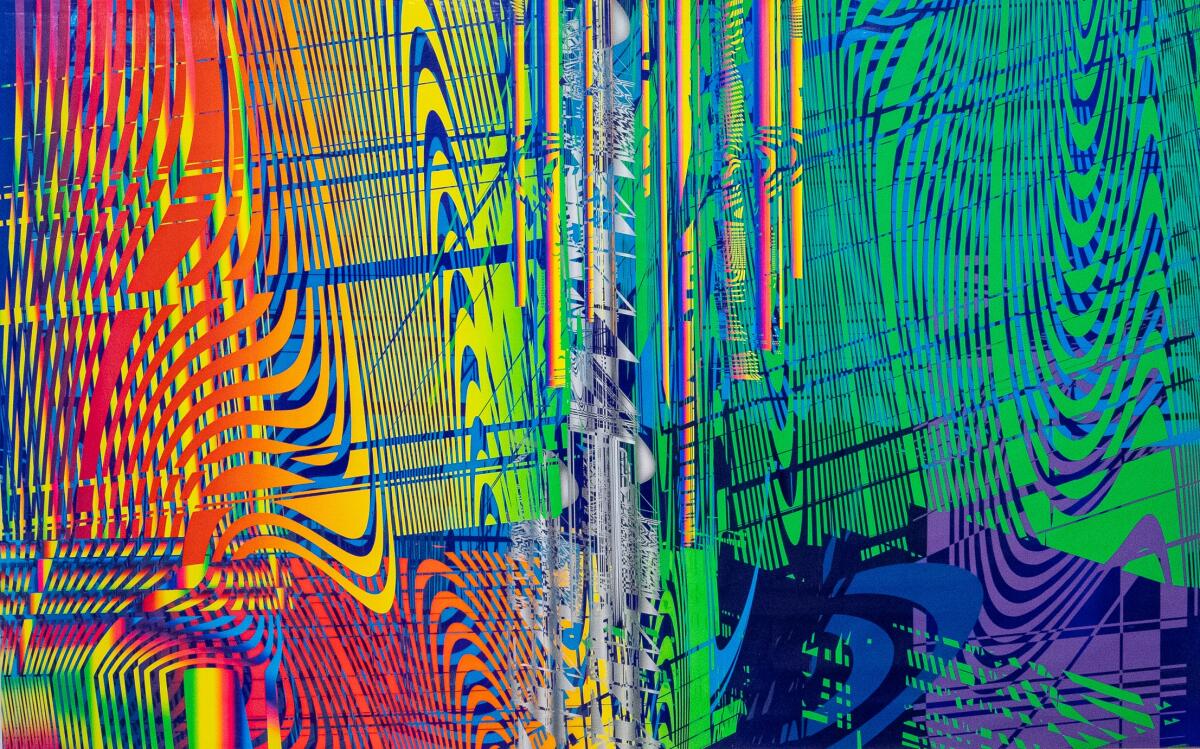
COVID-19 is not over, despite the political posturing of anti-government commentators and the absurd claims of some cosseted celebrities. Risk in Los Angeles County is currently low, according to the CDCâs COVID Data Tracker, but hundreds were hospitalized in the last week. Things are definitely in flux, a fact represented by the jumble of requirements that art spaces have in place for visiting. One museum will require advance reservations and proof of vaccination, another will wave a drop-in through the front door, no questions asked and mask optional. Itâs confusing.
Exhibitions postponed over the last few years are opening up in abundance, however, making for a suddenly crowded field. Recently, I donned my N95 respirator and caught up with several of them around town. Here are five that I saw:
All paint, no canvas
In 1993, painter Linda Besemer made a brushstroke that sent her on a path she has explored in her work for nearly three decades. At the Carolyn Campagna Kleefeld Contemporary Art Museum at Cal State Long Beach, 23 paintings, plus an informative selection of studies and sketches, offer a concise and absorbing survey of the Los Angeles-based artistâs career.
What made that 1993 brushstroke unusual is hinted at in the title of the work, which opens the show. âDetachable Stroke #1â is all paint, no canvas. No support undergirds Besemerâs brushstroke, 3 feet tall and 10 inches wide. Instead, a detached slather of acrylic paint hangs directly on the wall.
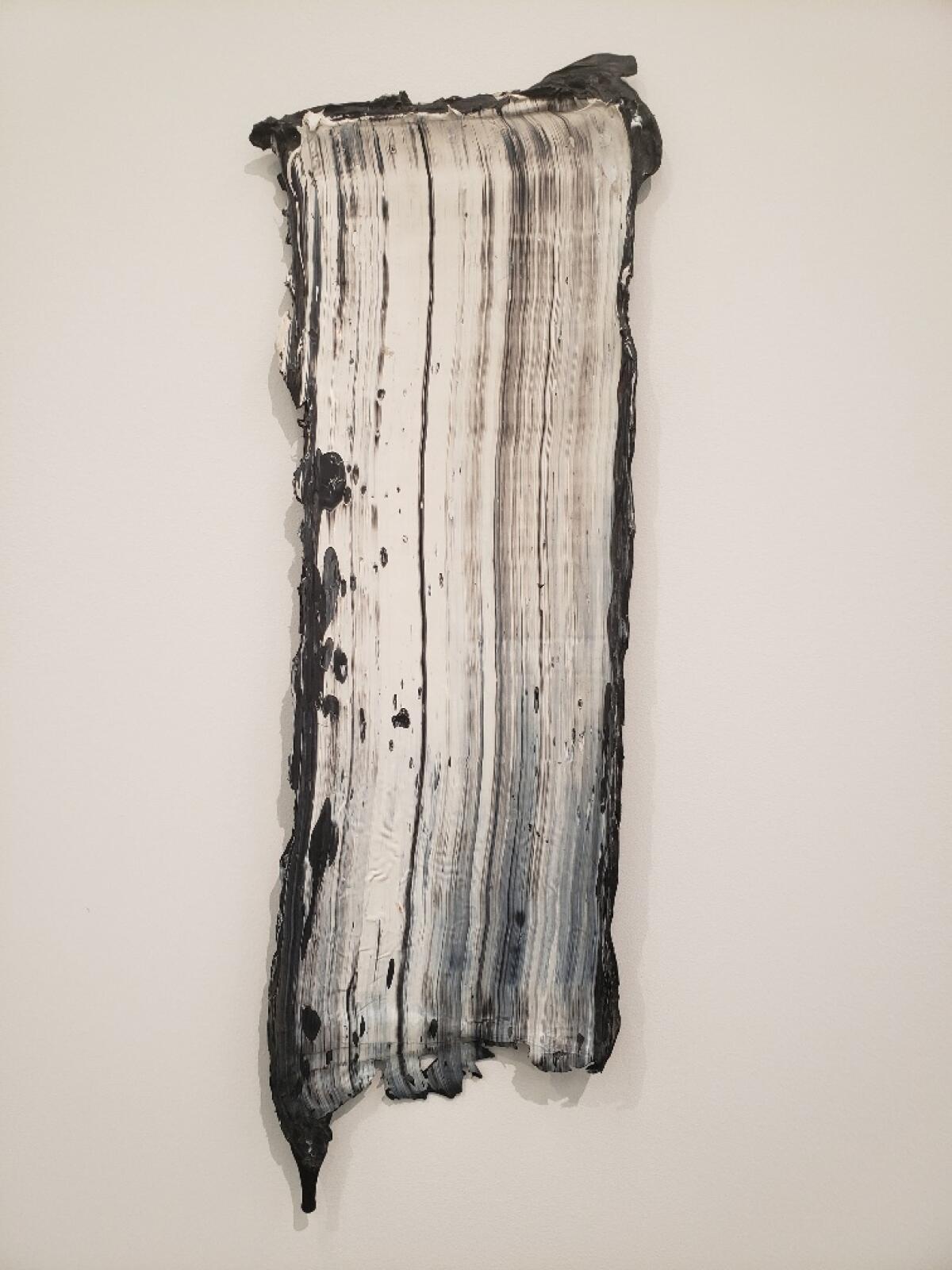
The slather looks a bit like it escaped from Roy Lichtensteinâs famous 1965 paintings of Abstract Expressionist brushstrokes, which he derived from a comic book illustration. But hers is not a picture. Itâs a three-dimensional object â a Pop Art sign materialized, as it were. Besemerâs paint mark appears to be black, white and gray, but look closely and a full color spectrum is embedded within it.
This is painting as paint, nothing more, which opened up a surprisingly complex set of considerations. The show, organized by former Kleefeld curator Kristina Newhouse, includes geometric and organic patterns of vivid color in loose sheets of paint that drape over rods, fold back on themselves, get carved up, slide off the wall and onto the floor and more. Optical illusions abound, further confounding the physical materiality of paint.
Besemer often composes her visually intense pictures with computer programs, sometimes inserting random digital noise into Utopian expectations for sleek mathematical perfection. (One painting is titled âSophieâs Neurosis,â wittily putting binary choice in its place.) The abstract visual clatter of a work like âTonyâs Painting,â all linear swoops and layered curls like a flat-screen TV on the fritz, jams the circuits. It caps her workâs larger point: Identity has been a productive subject for art since the 1990s, but asserting identity is not an answer. Instead, these confounding paintings insist, identity is a question.
An innovative approach to textile
At the Craft in America Center, Ferne Jacobs merges traditional, handmade textile and basketry technologies to birth an innovative genus entirely her own. Second-wave feminism in the 1960s fostered reconsiderations of craft production associated with women, and Jacobs took to the textile loom. The result, chronicled in 27 examples selected by curator Emily Zaiden, evolved over nearly 50 years in her Echo Park studio.
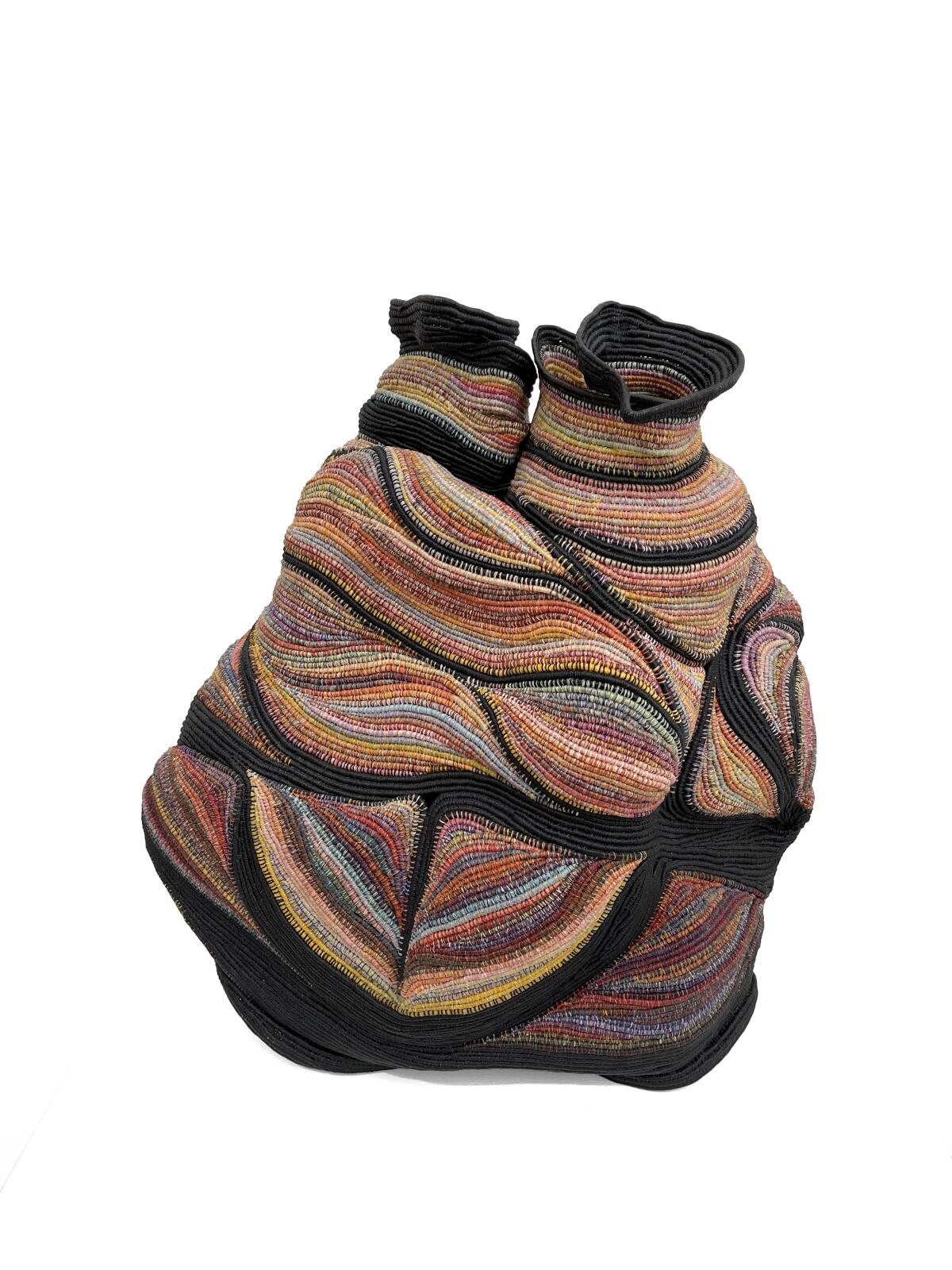
In the mid-1970s, she set the loom aside to make labor-intensive textiles with her hands â think all weft, no warp â coiling thread into long, thin, finely wrought ropes that Jacobs used to build basketlike forms. (Log in to the galleryâs website for video demonstrations.) âShadow Figureâ (1976-77) is a thin, wedge-shaped volume that stands 5 feet tall, leans against a wall and is open at the top, constructed from medium tan thread shot through in a few discrete places with red, white and blue. The deflated cavity, an abstract vessel, is loosely suggestive of bodily viscera.
Many of Jacobsâ thread sculptures evoke internal body parts, including orifices ranging from vulva to mouth, although almost never explicitly. Linear webs hang loosely on the wall, like residue from an autopsy surgeonâs scalpel, while snakelike shapes seem to be in the process of shedding their skin â ecdysis, as internal development outgrows its container.
Others rise precariously from the floor, as if determined to stand. Some, open at both top and bottom, could be imagined as magnificent headdresses.
Wall text aptly describes the general sculptural demeanor as totemic: With their inescapable displays of ritual repetition in the fabrication of coiled thread, the works seem to function as intuitively generated emblems that donât describe things in nature but instead embody their spirit. âThe Roundâ (2007-08) is among the most beautiful: A nearly 2-foot-tall pair of lumpy, voluptuous, vibrantly multicolored vessels has next to no figurative qualities, but the forms nonetheless appear to be locked in a powerful embrace.
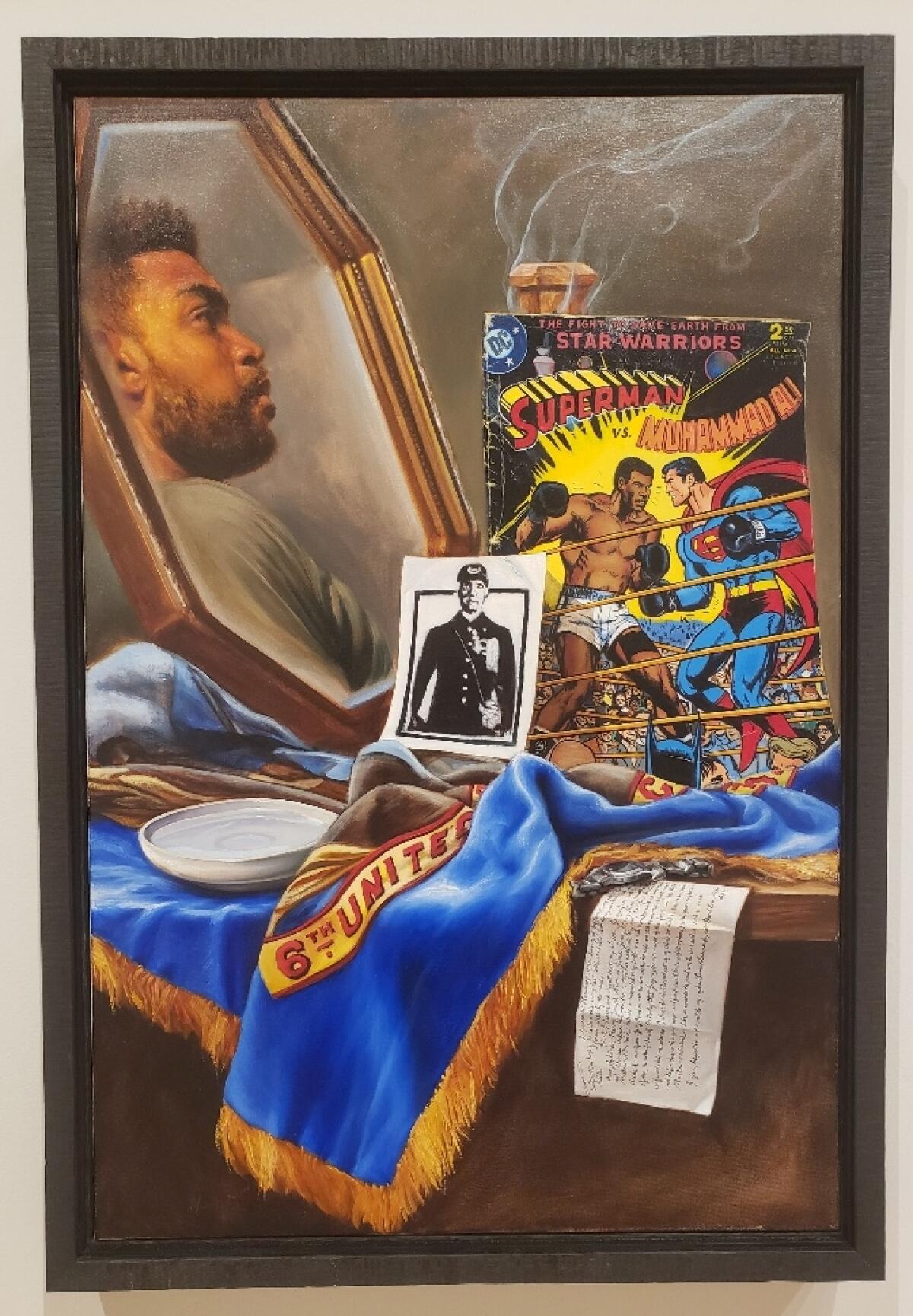
Skillful, figurative paint-handling
The invigorating show of 29 paintings and three drawings from the past dozen years by Detroit-based artist Mario Moore at the California African American Museum opens with a 2010 self-portrait in the guise of a history painting. The picture resonates far beyond its clear demonstration of skillful figurative paint-handling.
Mooreâs lifeless severed head is shown, like John the Baptist, poised atop a silver platter held by Herodias, her torso lavishly attired in garments of purest white. Mooreâs close-up framing of the composition slyly cuts off her head too.
Picturing a Black man slaughtered at the behest of a white woman whose honor has supposedly been slighted puts the 1955 murder of 14-year-old Emmett Till â a brutal crime instrumental in catalyzing the American civil rights movement â squarely in mind. Mooreâs paintbrush layers history in evocative ways, while inserting himself into a universalized scene pulls social havoc into the present.
The Detroit Institute of Arts in Mooreâs hometown is one of the nationâs greatest art museums, and he repeatedly draws on painterly tropes from art history for contemporary narratives. Stylistically, he tends to go for Baroque theatricality or Neoclassical grandeur.
A lovely portrait of a CAAM custodian visiting the Exposition Park Rose Garden balances her patient face with a big, luxurious blossom, which seems to beckon her across the field to come smell the roses. A second self-portrait deploys the artist as a surprising odalisque, albeit fully attired in an urban ensemble of T-shirt, baggy jeans and heavy work boots while stretched out on a rustic chaise before a tranquil pond in a sunny woodland. The serene rural scene demands to know: So, who doesnât belong where, doing what?
Thereâs a lot to read, pictorially speaking, in Mooreâs show, ably selected by curator Taylor Renee Aldridge. A marvelous culmination is âVanitas: The Fight,â a still life built around an old master-style self-portrait reflected in a mirror and a famous comic book of pugilistic Superman battling Muhammad Ali, while Batman looks on ringside. Cascading from the tableâs edge is a manumission document releasing a family named Moore from chattel slavery as burning incense and a nearby plate of water quietly consecrate the sober scene.
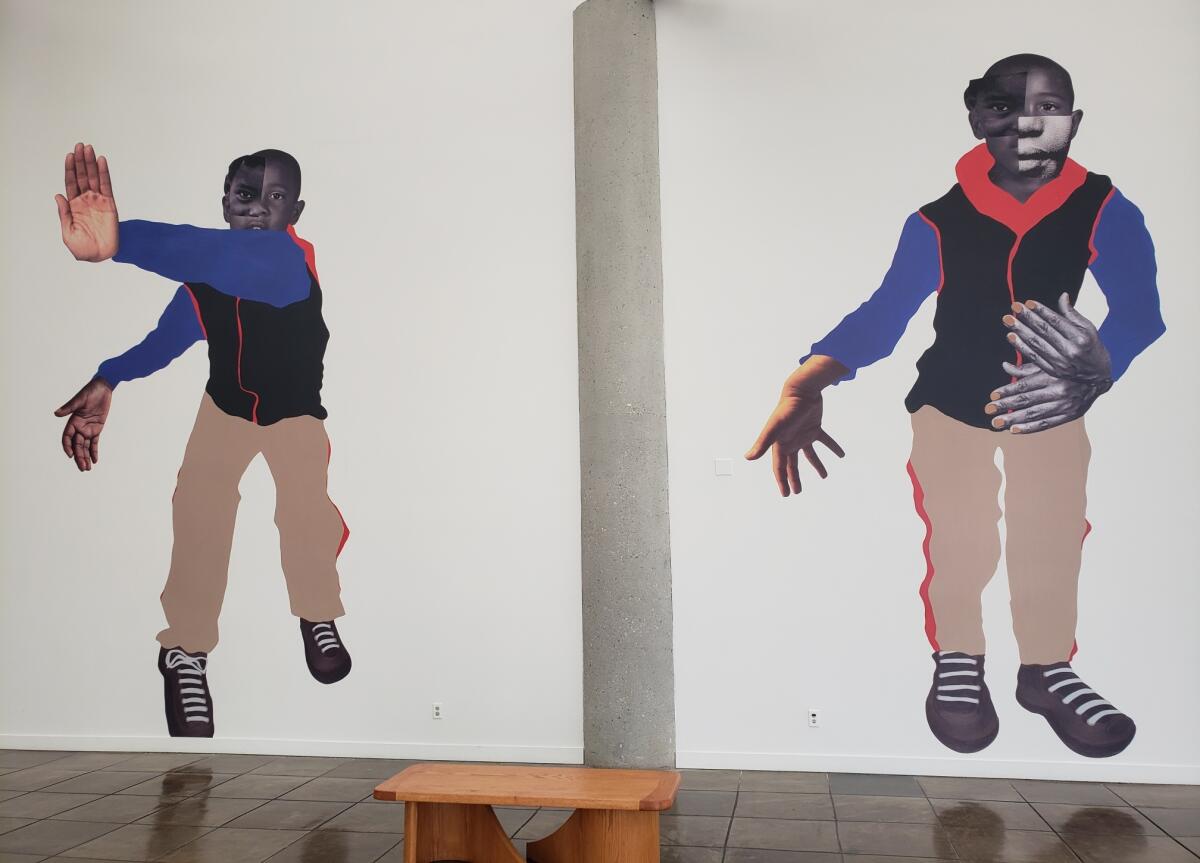
Monumental collages and murals
The lobby at CAAM currently features a five-part monumental collage-mural by Texas-based Deborah Roberts, part of a traveling exhibition organized by the Contemporary Austin and shared with Art + Practice in Leimert Park. âLittle man, little manâ (2020), titled after James Baldwinâs only childrenâs book, arrays visions of a young Black boy making outsize gestures somewhere between dance moves, sports motions and the urgent signals of a human semaphore.
Unlike the scribbly, energetic line in the original book illustrations by French artist Yoran Cazac, Robertsâ collaged images bring sturdy heft to the agile young man. His face is constructed from fragments of other faces, assembled with an assured hand. (His own collaged hands are often enormous.) Fracturing simplifies and distills a technique pioneered by collage master Romare Bearden, which itself built on the African art inspirations of Cubism a century ago. The boyâs assembled face is male, female, indeterminate, old and young, and it features a wide array of shades of Black skin. Heâs at once joyfully communal and determinedly unique.
Nine of Robertsâ collage-and-pencil works on canvas at Art + Practice, plus nine from a suite of 27 Warhol-style silk-screen heads, elaborate the theme, introducing girls and kids in groups. (In a nice touch, the silk screens are hung low on the wall â kid-height.) Roberts places her figures off-center against blank white fields, her unerring design sense yielding the savvy effect of a fashion shoot. Given a larger absence of Black faces in commercial culture, these kids insert themselves â camera-ready.
In the rear gallery, two old-fashioned photo booths are transformed into video stalls, filled with a mirrored wall, text in raised felt, a recitation of names and an animation of multicolored paper and $20 bills â notably featuring the face of tyrant Andrew Jackson, not yet replaced by Harriet Tubman, heroine of the Underground Railroad. Jumbled, the installationâs collage of text and image doesnât quite work, especially compared to the resonant clarity of Robertsâ pictorial work.

Dazzling textiles printed with silk screens
Finally, at the Fowler Museum at UCLA, âAboriginal Screen-Printed Textiles From Australiaâs Top Endâ offers a gorgeous selection of textiles printed with silk screens in mostly bold patterns and vibrant hues. They have been produced since the 1980s by 45 artists working at five Aboriginal-owned art centers in northern coastal regions in the vicinity of Darwin (Australiaâs âTop Endâ). The communities â Tiwi, Jilamara, Injalak, BĂĄbbarra and Merrepen â are small, with populations ranging from a few hundred to a few thousand.
Printed on silk, cotton, linen and other materials using traditional screen-printing techniques â cut stencils or, on occasion, photo transfers â the imagery is figurative as well as abstract. It can represent simple survival objects (fishing traps, fruits, emergency vehicles, palms, burial posts) or esoteric symbols, some legible only to the Aboriginal clan. Thereâs something appealing about a secret sign language being manufactured into cloth used for commerce in clothing or furnishings â an International Clandestine style.
Among the dazzlers are fine linen panels by Susan Marawarr with copper-metallic striations printed over deep-black crosshatching. (The optical shimmer is like heat rising from the desert floor.) Sonia Namarnyilk layered three stencils to print complex patterns of mermaid-like water spirits, their fluid, bright orange undulations interspersed with playful turtles and rippling billabong plants.
Interlocking waves of blue and white lines punctuated with dots by Kieren Karritpul turn memories of knotted fishnets made by his mom and grandmother into patterns of immensely sophisticated spatial rhythms. The same goes for the crimson moon and stars over silver and gray bands in a Bede Tungutalum textile, which a wall label explains derives from a harvest ritual at the end of monsoon season.
Traditional Aboriginal bark and body painting gained international notice in the 1960s as jet travel shrank the world. In the 1980s, during an art market boom, the paintings entered the commercial mainstream, often to the exploitative detriment of the communities that made them. Textile printing became one means for some of those communities to regain a degree of control, putting their artistic skills to commercial use for their own benefit. The exhibition and its lush catalog, organized by Fowler curator Joanna Barrkman, is a measure of its success.
âLinda Besemer: StrokeRollFoldSheetSlabGlitch,â CSULB Kleefeld Contemporary, 1250 N. Bellflower Blvd., Long Beach, through June 25. csulb.edu
âBuilding the Essentials: Ferne Jacobs,â Craft in America Center, 8415 W. 3rd St., through June 18. craftinamerica.org
âMario Moore | Enshrined: Presence + Preservation,â California African American Museum, 600 State Drive, Exposition Park, through Oct. 2. caamuseum.org
âDeborah Roberts: Iâm,â California African American Museum, 600 State Drive, Exposition Park; and Art + Practice, 3401 W. 43rd Place, through Aug. 20. artandpractice.org
âAboriginal Screen-Printed Textiles From Australiaâs Top End,â Fowler Museum at UCLA, 308 Charles E. Young Drive N., Westwood, through July 10. fowler.ucla.edu
More to Read
The biggest entertainment stories
Get our big stories about Hollywood, film, television, music, arts, culture and more right in your inbox as soon as they publish.
You may occasionally receive promotional content from the Los Angeles Times.











